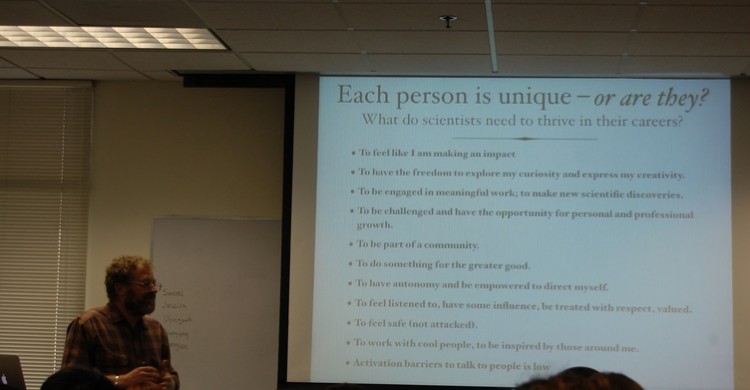
On December 4th, Ron Zuckermann gave a talk on building relationships with mentees and collaborators. Ron began his talk with a brief history of his career development.
Ron is currently the Facility Director of the Biological Nanostructures Facility at the Molecular Foundry, at Lawrence Berkeley National Lab. As a director of a national lab facility, it’s his job to provide an environment for the science to thrive, which equates to an environment where people thrive. As such, he’s put a lot of thought into what people need to thrive in the workplace.
Through his previous career experiences, he’s been able to compile a list of what he believed he would need to thrive in his career. He then went on to say that each person is not unique in what they need to succeed. In one of his slides, he listed what he believed a person would need to thrive.
The list included, but was not limited to, things like:
He discussed some topics in psychology relevant to meeting these needs and what needs we have, such as Maslow’s hierarchy of needs, self-determination theory and flow. He went on to discuss the different types of communication styles (dominant, passive, passive-aggressive and empathetic) and how they can effect the workplace.
Afterwards, many students in the audience asked poignant questions that further developed into stimulating conversation. One student who attended this talk, Anisa Myzaferi, commented afterwards on the talk, “I really appreciated GSDS hosting this open forum event to address these skills with such an honest senior scientist. By giving examples from his own career, Dr. Zuckermann elucidated the kinds of people we encounter and the power relationships that often arise in research settings. He gave us some very logical steps to take towards building empathetic and supportive work partnerships that preempt conflict. I was reminded of the power of honesty and openness to avoid misunderstandings between colleagues. I think it is so important to take a step back and remember that there’s room for everyone to be a successful scientist. Dr. Zuckermann’s thoughts and advice accomplished just that.”
Further reading on these topics discussed during Ron’s talk can be found here:
What motivates people?
“Drive: The surprising truth about what motivates us” by D. H. Pink (2009):
http://www.amazon.com/Drive-Surprising-Truth-About-Motivates/dp/1594488843
The concept of Flow:
“Finding Flow: The Psychology of Engagement With Everyday Life” by M. Csíkszentmihályi, Basic Books (1996).
https://en.wikipedia.org/wiki/Flow_(psychology)
Maslow’s Hierarchy of Needs:
H. Maslow, “A Theory of Human Motivation”, Psychological Review, 50, 370 (1943)
https://en.wikipedia.org/wiki/Maslow%27s_hierarchy_of_needs
Communication styles:
“Communication Strategies for Achieving a Total Safety Culture”, J. Williams & S. Geller. EH&S Today, July 7, 2008:
http://ehstoday.com/safety/ehs_imp_81509/
Crucial Conversations:
“Crucial Conversations: Tools for talking when the stakes are high” by K. Patterson (2002). http://www.amazon.com/Crucial-Conversations-Talking-Stakes-Second/dp/1469266822
Emotional Intelligence:
“Emotional Intelligence” by Daniel Goleman (1996).
Creating environments for “smart creatives” to thrive:
“How Google Works”, Eric Schmidt & Jonathan Rosenberg (2014).
Non-defensive communication:
“Taking the War Out of Our Words: The Art of Powerful Non-Defensive Communication”, Sharon Ellison (2002).